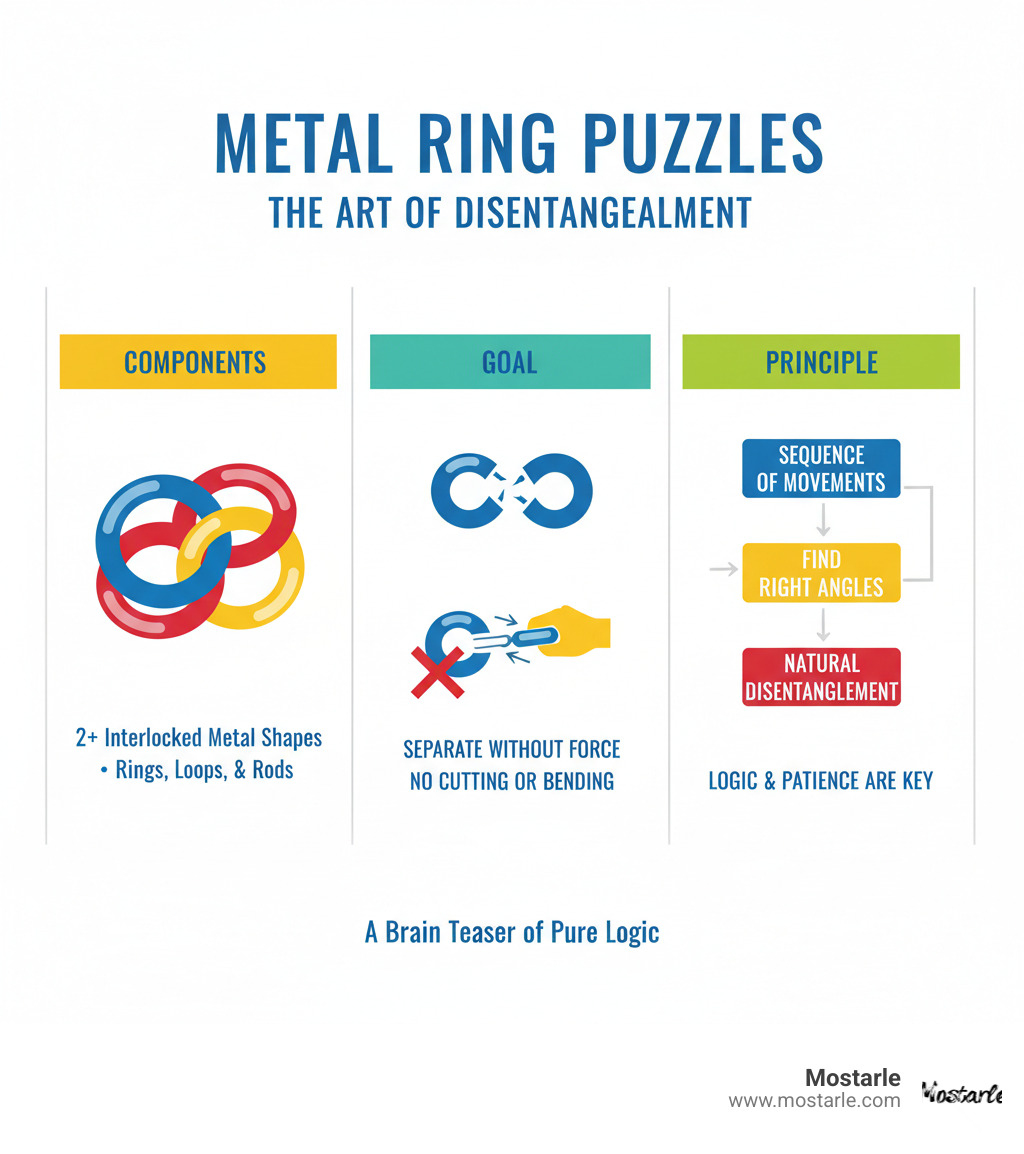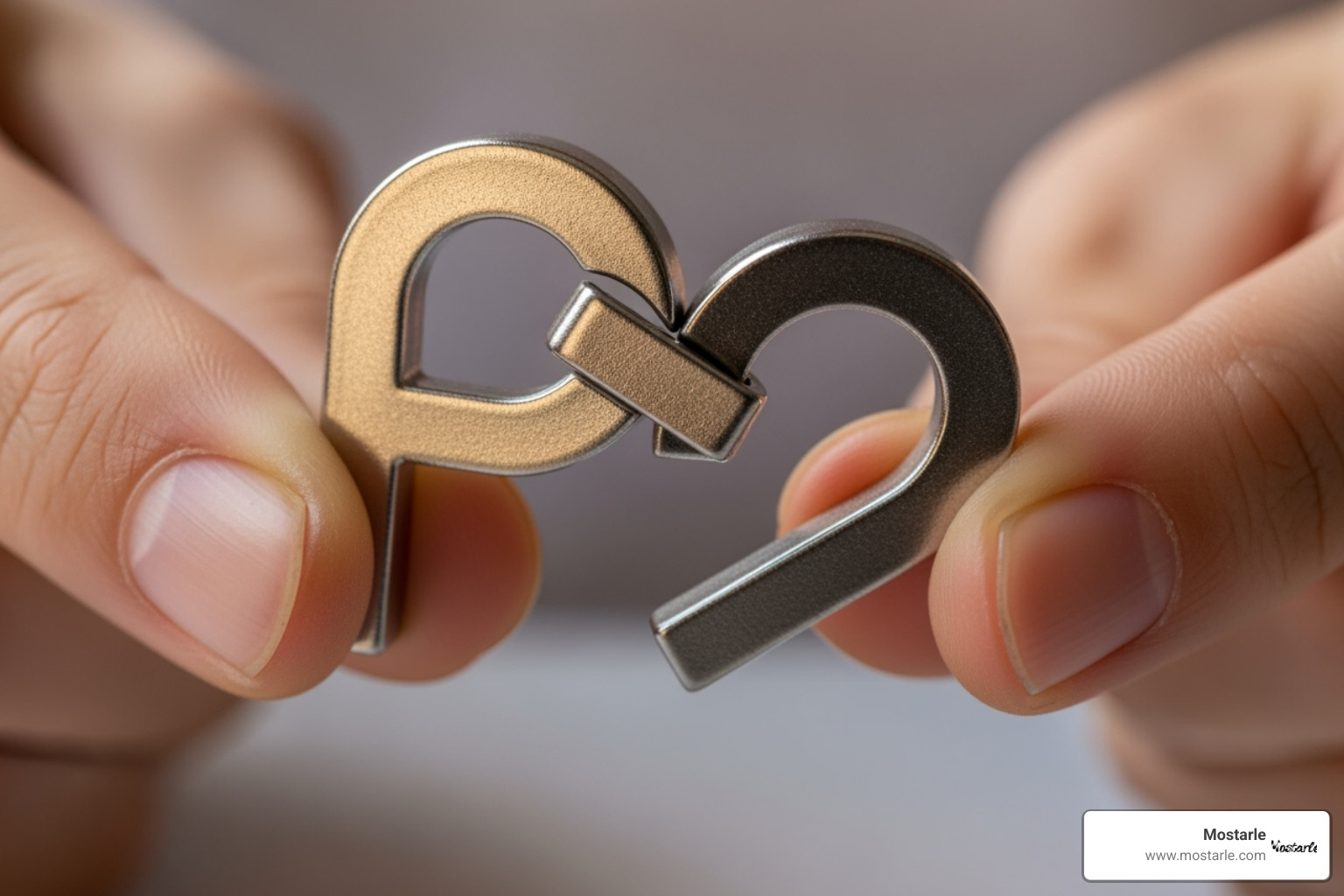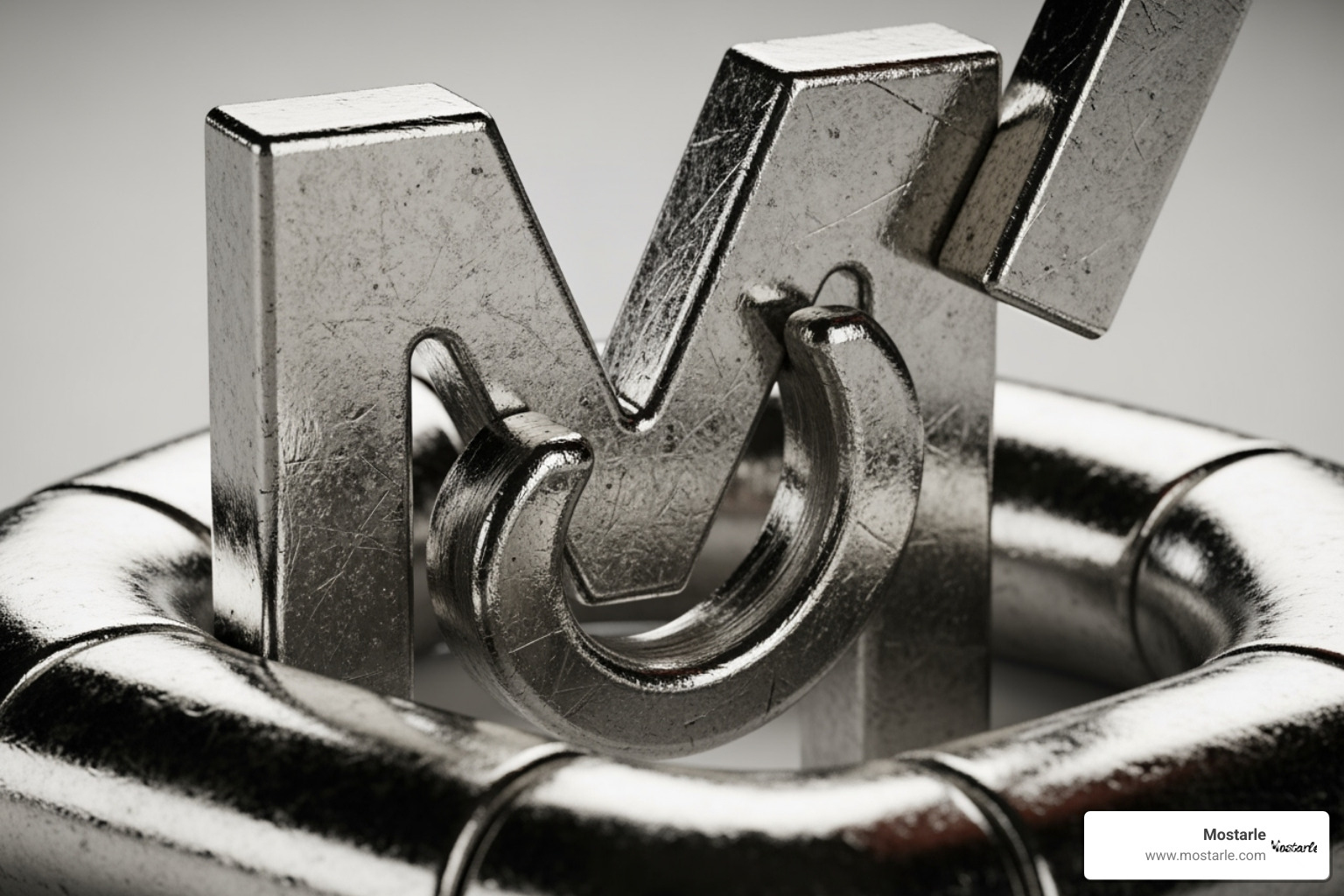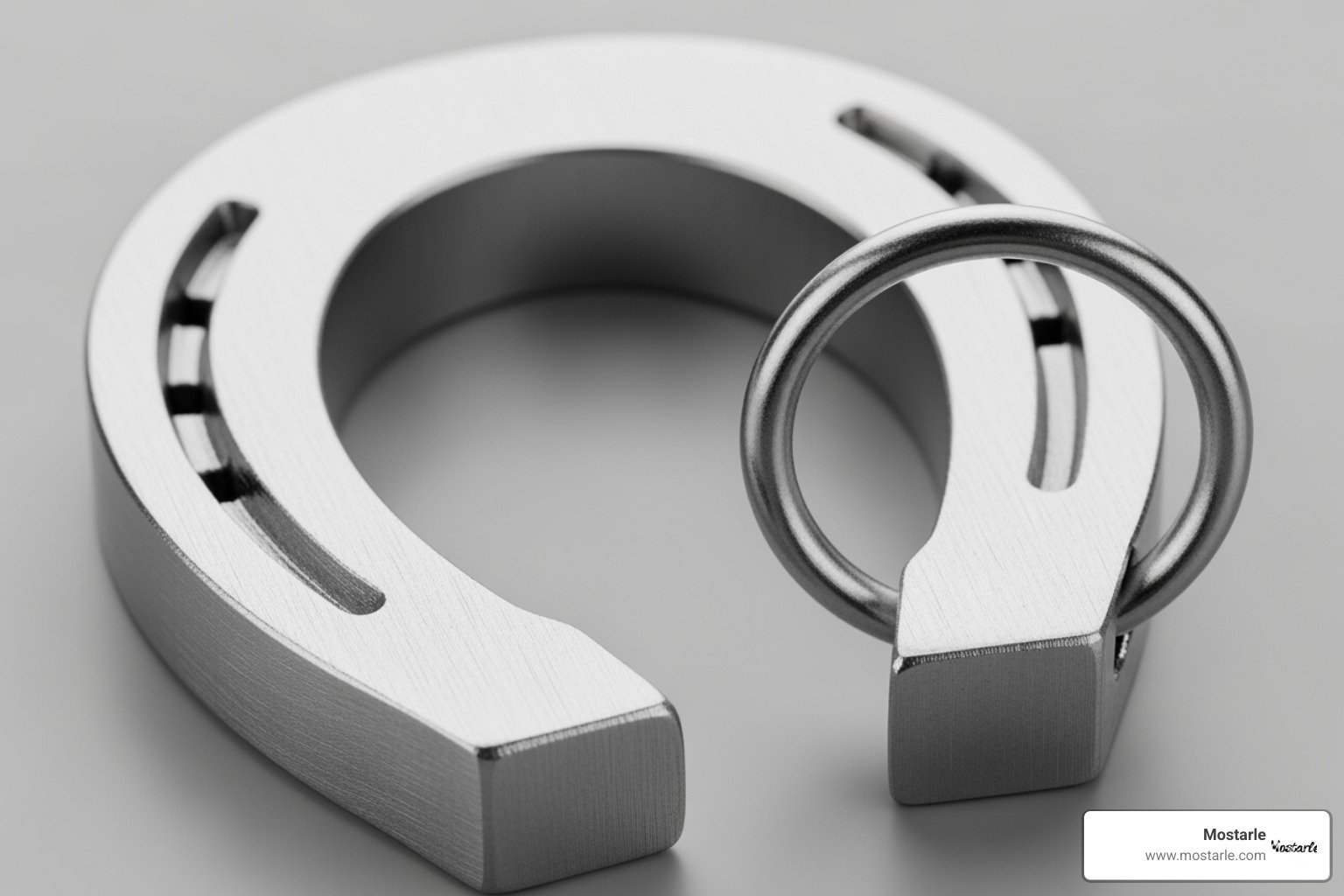
The Art of Disentanglement: Solving Intricate Metal Ring Puzzles
Your Gateway to the World of Metal Puzzles
A metal ring puzzle is a classic dismess brain teaser where you manipulate interlocked metal pieces to separate or remove rings without cutting or forcing the components. Here are the most common types and their basic solving approaches:
Popular Metal Ring Puzzle Types:
- P-Shaped Puzzle - Form a heart shape, then loop one ring through the other
- Double M Puzzle - Turn rings 90 degrees and slide through the curved sections
- Horseshoe Ring Puzzle - Twist one horseshoe, align the pieces, then slide the ring off
- L-Shaped Puzzle - Position pieces to form an 'M' shape and hook the curved sections
- Captive Ring - Tilt rings at specific angles to overlap and pass through
These fascinating brain teasers have challenged minds for centuries. The Cast Ring II puzzle traces back to at least the 15th century, while the Captive Ring gained popularity in 19th-century Europe and America.
Metal ring puzzles offer the perfect escape from the ordinary - they're tangible expressions of creativity that transform idle moments into rewarding mental adventures. Unlike digital entertainment, these puzzles engage your hands and mind simultaneously, creating a meditative flow state that's both challenging and deeply satisfying.
In this guide, you'll find the secrets behind solving the most popular metal ring puzzles, learn expert techniques that prevent frustration, and understand why these ancient brain teasers remain irresistibly engaging today.

From Ancient Locks to Modern Brain Teasers: A Brief History
Picture this: centuries ago, someone looked at a complex lock mechanism and thought, "What if we made this just for fun?" That's essentially how metal ring puzzles came to be, born from the marriage of practical engineering and human curiosity.
Dismess puzzles have been challenging minds far longer than you might expect. The Chinese Ring Puzzle, known as Baguenaudier (which charmingly translates to "time-waster" in French), represents some of the earliest forms of these brain teasers. These ancient puzzles featured multiple rings linked together in sequences that required specific moves to solve—like a mathematical dance your hands had to learn.
The 15th century marked a pivotal moment when these puzzles began evolving from simple curiosities into sophisticated challenges. What started as practical locking mechanisms slowly transformed into pure entertainment, each design more clever than the last.
But it was during the 19th century that metal ring puzzles truly captured the public imagination. Victorian parlors across Europe and America buzzed with the clicking and clinking of metal as people wrestled with these mechanical mysteries. The Captive Ring puzzle became particularly beloved during this era—a testament to how these simple yet ingenious designs could captivate entire generations.
The beauty of these puzzles lies in their evolution of design. Each generation of puzzle makers built upon the work of those before them, refining mechanisms and finding new ways to challenge the mind. What began as thick wire bent into basic shapes gradually became intricate masterpieces of engineering, each telling its own story of human creativity.
These puzzles prove that some of the best ideas are timeless. The same principles that delighted puzzle enthusiasts centuries ago continue to challenge and reward us today, connecting us to generations of curious minds who refused to let a good mystery go unsolved.
Want to dive deeper into this fascinating world? Check out more about the history of mechanical puzzles to find how these ingenious creations shaped the puzzle landscape we know today.
A Step-by-Step Guide to Solving Popular Metal Ring Puzzles
Here's the truth about metal ring puzzles: they're not meant to be wrestled into submission. These clever little brain teasers require a completely different approach than you might expect. Patience is absolutely key – rushing will only leave you frustrated and possibly with sore fingers.
The secret lies in understanding the mechanics of each puzzle. Every twist, curve, and angle serves a purpose. Think of it like learning a new dance – once you understand the rhythm and sequence, the movements flow naturally.
Most importantly, never use brute force. These puzzles are designed with neat solutions that require finesse, not strength. If you find yourself forcing pieces, take a step back and reconsider your approach.
How to Solve the P-Shaped Metal Ring Puzzle
The P-shaped puzzle might look simple, but don't let appearances fool you. This classic dismess challenge typically involves two P-shaped pieces or a P-shaped piece with a loose ring that seem impossibly tangled together.
Start by holding one end of each piece evenly in your hands. This gives you proper control and prevents accidental twisting that could complicate the solution.
The magic happens when you form a heart shape by rotating one of the P-shaped pieces downward. This subtle movement creates the crucial alignment that opens up the pathway for separation. It's like finding the hidden door in a maze – once you see it, everything clicks into place.

Once you've formed that heart shape, carefully loop the other ring through the upper curve. With a gentle but confident pull, guide the piece through the loop. When done correctly, the pieces will separate with satisfying ease.
Resetting the puzzle is simply a matter of reversing these steps. Slide one ring back through the P-loop of the other, align them properly, and they'll interlock into their original configuration. Interestingly, most people find reassembly easier once they've mastered the separation technique.
You can see the P-shaped solution in action if you prefer a visual guide to complement these instructions.
How to Solve the Double M ('Devil') Puzzle
Ah, the Double M puzzle – sometimes called 'The Devil Puzzle' for good reason! This intricate brain teaser consists of two M-shaped pieces that interlock in a way that seems to defy logic.
Begin by lifting one M-shaped ring slightly above the other, positioning their curved sections to face opposite directions. This initial alignment creates the space you'll need for the next crucial step.
Now comes the 90-degree turn – rotate the rings relative to each other until you can see how one M's curve might accommodate the other's passage. This positioning is everything in this puzzle.

The real artistry comes in sliding through the curve. Carefully guide the bottom M-piece upward through the curve of the top piece. This requires a delicate touch and precise angles – think of threading a needle, but in three dimensions.
Finally, lower the bottom piece through the middle of the top M's shape. With some gentle maneuvering and proper alignment, the pieces will suddenly separate, often surprising first-time solvers with how smoothly it happens.
Resetting the puzzle follows the same logic in reverse: raise one ring through the middle of the other's M-shape, twist 90 degrees, slide over the top curve, and guide it down to secure the interlock.
If these written instructions feel a bit abstract, don't worry – you can watch a Double M puzzle tutorial to see these movements demonstrated step by step.
How to Solve the Horseshoe Ring Puzzle
The Horseshoe Ring Puzzle presents a different kind of challenge altogether. This classic typically features two horseshoe-shaped pieces connected by a chain, with a ring seemingly trapped on one of the horseshoes. Your mission? Free that ring without cutting anything.
Start by holding both horseshoes evenly – this balance prevents the chain from twisting unnecessarily and keeps the ring properly positioned. Now, twist one horseshoe counterclockwise until it feels snug. Don't force it; you're just changing the geometry slightly to create new possibilities.
The key moment comes when you align the pieces by carefully bending the horseshoes together in the middle. You're looking to create a path or moment of slack where the ring can finally pass through. This might require some experimentation with angles – each puzzle has its sweet spot.

As you align the horseshoes, the ring should naturally fall to the bottom where they meet. From there, you can gently slide the ring off one of the horseshoes. If it seems stuck, double-check your horseshoe alignment and ensure the chain isn't twisted.
Resetting the puzzle requires the same twisting and bending technique to align the horseshoes, then dropping the ring through one end. Fold the horseshoes back up and twist one clockwise (opposite direction) to secure the ring in its trapped position again.
For those who enjoy building their own puzzles or want even more detailed instructions, you can learn how to solve the horseshoe puzzle with comprehensive guidance.
The Brain-Boosting Benefits of Puzzle Solving
There's something magical that happens when you finally separate those stubborn metal pieces after minutes (or let's be honest, sometimes hours) of concentrated effort. That satisfying "click" isn't just the sound of success – it's your brain celebrating a genuine workout.
Every time you pick up a metal ring puzzle, you're essentially giving your mind a trip to the gym. These deceptively simple challenges are powerhouses for developing problem-solving skills. Each puzzle presents a unique riddle that demands you break down the challenge, spot patterns, and work through solutions step by step. It's like learning to be a detective, but way more fun and with less paperwork.
Spatial reasoning gets a major boost too. As you twist, turn, and manipulate those metal pieces, your brain is working overtime to visualize how objects move and fit together in three-dimensional space. You start understanding angles and relationships between components in ways that can actually help with everything from reading maps to assembling furniture (finally, those IKEA instructions might make sense!).
But perhaps the most valuable skill these puzzles teach is patience and perseverance. We've all been there – staring at a tangled mess of metal, wondering if the puzzle maker was secretly evil. Those moments of frustration? They're building something important: resilience. When you finally crack the code after persistent effort, that rush of accomplishment teaches your brain that sticking with challenges pays off.
Here's where it gets really interesting: working on these puzzles can actually provide genuine stress relief. In our constantly buzzing, notification-filled world, focusing completely on manipulating a physical puzzle creates a kind of meditation. Your mind gets a break from worries and anxiety, finding calm in the tactile challenge of solving something real and concrete.
This isn't just feel-good thinking – there's real science behind the healing power of mechanical puzzles. These little metal contraptions offer a sense of control and accomplishment that's increasingly rare in our digital age.
Want to explore more ways to give your brain a boost? Check out our guide on how to boost your brain power with puzzles. Trust us – your future self will thank you for every minute spent untangling those metal rings.
Expert Tips and Further Resources
Even the most seasoned puzzle enthusiasts find themselves staring at a tangled metal ring puzzle wondering where they went wrong. Don't worry – we've all been there! The beauty of these challenges lies not just in solving them, but in learning the subtle techniques that transform frustration into triumph.
General Tips for Solving Any Metal Ring Puzzle
The difference between puzzle mastery and endless frustration often comes down to approach. Hold your puzzle evenly – this simple habit gives you better control and prevents those accidental twists that can set you back to square one. Think of it like holding a delicate instrument rather than wrestling with it.
Align the pieces horizontally before you begin. This neutral starting position helps you see the puzzle's natural pathways more clearly. It's like getting your bearings before setting off on a journey.
Here's the golden rule that separates beginners from experts: don't force it. If a piece isn't moving smoothly, you haven't found the right angle or sequence yet. The solution to every metal ring puzzle is neat and requires finesse, not muscle. Brute force will only leave you with sore fingers and a damaged puzzle.
When you feel stuck, take a break. Sometimes the best breakthroughs happen when you step away and let your subconscious work on the problem. A fresh perspective after a cup of tea can reveal solutions that were hiding in plain sight.
If you've partially separated some pieces but then get stuck, try to reverse your steps. Understanding how the puzzle goes back together often illuminates the path forward. It's like learning a dance – sometimes you need to step backward to move forward gracefully.
Pay attention to moments when a piece suddenly feels looser or gains a tiny bit of movement. These hints of freedom usually signal you're on the right track. The puzzle is starting to reveal its secrets.
For more advanced strategies that work across different types of brain teasers, check out our 9 tips for solving difficult 3D puzzles.
Where to Find More Puzzle Solutions
Sometimes even the best techniques aren't enough, and that's perfectly okay! Seeking help isn't giving up – it's learning. YouTube tutorials are often your best friend when you need to see the solution in action. Search for your specific puzzle name, and you'll usually find detailed video guides from fellow puzzle lovers.
Puzzle forums and communities create wonderful spaces where enthusiasts share strategies and offer encouragement. These communities understand the unique satisfaction of finally cracking a stubborn puzzle, and they're always willing to offer hints without spoiling the fun.
Manufacturer websites frequently provide official solution guides, sometimes as downloadable PDFs or step-by-step videos. These resources come straight from the puzzle creators, so you know the techniques are reliable.
Specialized puzzle blogs offer another treasure trove of information. Dedicated enthusiasts often share detailed solving experiences and unique insights that you won't find anywhere else.
Using a solution guide isn't cheating – it's a learning opportunity. Once you see how it works, practice the sequence until it becomes natural. The real satisfaction comes from understanding the neat logic behind each metal ring puzzle and being able to solve it confidently on your own.
Frequently Asked Questions about Metal Puzzles
Let's be honest – when you first pick up a metal ring puzzle, you probably have the same questions we all do. These fascinating brain teasers can be both captivating and confusing, so we've gathered the most common questions to help clear things up.
What are the most common types of metal ring puzzles?
If you've wandered into metal puzzles, you've probably noticed there are quite a few different styles out there. The most popular ones we see time and again include the P-shaped puzzles that form heart shapes when you're solving them, and the tricky Double M puzzles (sometimes called 'Devil' puzzles for good reason!).
You'll also encounter L-shaped puzzles that require you to form specific alignments, and the classic Horseshoe puzzles with their chains and trapped rings. The Captive Ring puzzles, also known as Magic Loops, have been stumping people since the 1800s – they're the ones where a ring seems impossibly trapped on a wire frame.
Then there are the ancient Chinese Rings, or Baguenaudier, which can involve a whole series of linked rings that need to be freed in a specific sequence. It's amazing how these simple concepts can create such delightfully complex challenges!
Are metal puzzles good for your brain?
This is one of our favorite questions because the answer is a resounding yes! Metal ring puzzles aren't just entertaining – they're like a workout for your mind.
When you're wrestling with one of these puzzles, you're giving your brain some serious cognitive stimulation. You're analyzing problems, thinking logically, and exercising those critical thinking muscles. Your memory gets a boost too, especially when you're trying to remember sequences of moves or recall how you solved a puzzle before.
The spatial awareness benefits are particularly impressive. All that visualizing of how pieces move and fit together in three dimensions really sharpens your spatial reasoning skills. Plus, there's something wonderfully meditative about focusing on a puzzle – it can actually help reduce stress and improve your ability to concentrate.
Maybe best of all, these puzzles teach patience and build resilience. Every time you push through frustration to reach that "aha!" moment, you're strengthening your mental fortitude.
What should I do if I get completely stuck on a puzzle?
We've all been there – staring at a tangled mess of metal, wondering if the puzzle is actually solvable or if someone's playing a cruel joke on us! Don't worry, getting stuck is completely normal and part of the fun.
Take a break first. Seriously, walk away for a bit. Your brain keeps working on the problem even when you're not actively thinking about it. You'd be amazed how often the solution becomes obvious after you've given your mind a rest.
When you come back, look at it from a new angle – literally. Turn the puzzle around, flip it over, hold it differently. Sometimes a fresh perspective reveals something you missed completely.
If you've made some progress but hit a wall, try to reverse the steps from the beginning. Understanding how the puzzle goes back together can often illuminate the path forward. It's like reading the story backward to understand the plot better.
Watch a video tutorial as a last resort, but here's a tip from our experience: only watch enough to get unstuck, then pause and try to figure out the rest yourself. The real satisfaction comes from understanding the solution, not just seeing it. Every expert was once a beginner who refused to give up!
Conclusion: Accept the Challenge of Dismess
As we've journeyed through the fascinating world of metal ring puzzles together, we've uncovered so much more than just clever metal contraptions. We've explored their rich history stretching back centuries, mastered the intricate steps to solve popular designs, and finded the profound ways these puzzles actually boost our brains.
Think about it – every time you successfully disentangle a stubborn horseshoe puzzle or guide those tricky Double M pieces apart, you're not just solving a puzzle. You're building patience and perseverance, sharpening your problem-solving skills, and giving your mind a genuine workout. In our digital world, there's something deeply satisfying about holding a tangible challenge in your hands.
That sense of accomplishment when the final ring separates? When the pieces click perfectly back into place after what felt like an impossible tangle? It's pure magic. It reminds us that the best solutions often require us to slow down, think differently, and trust the process.
The art of patience isn't just about waiting – it's about understanding that some of life's most rewarding moments come from persistent, focused effort. These puzzles teach us exactly that lesson, one careful movement at a time.
At Mostarle, we see a beautiful connection between metal ring puzzles and our own creative philosophy. Just as we transform everyday nuts and bolts into remarkable art pieces, these puzzles take simple metal rings and lift them into captivating brain teasers. Both prove that creativity has no limits when we look beyond the obvious and find elegance in unexpected places.
Whether you're already a puzzle master or just picked up your first metal ring puzzle, we encourage you to accept these challenges. Let your mind wander through the possibilities, celebrate those "aha!" moments, and remember that every expert was once a beginner who refused to give up.
Your next breakthrough is waiting – all it takes is curiosity, patience, and the willingness to see ordinary metal pieces as extraordinary opportunities for findy.
Ready to explore even more intricate challenges? Continue your journey with our guide to 3D metal puzzles and find new dimensions of creative problem-solving.

